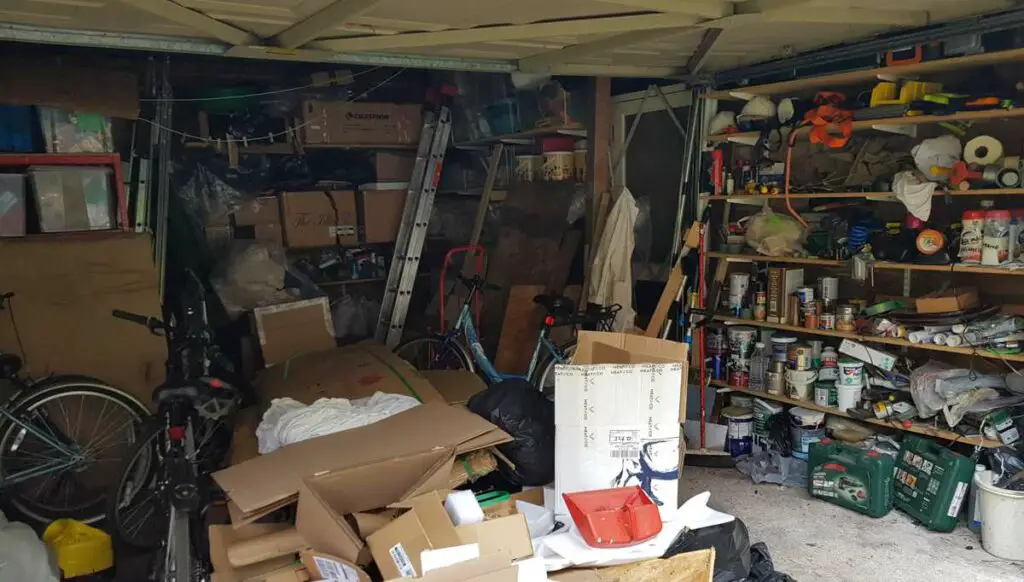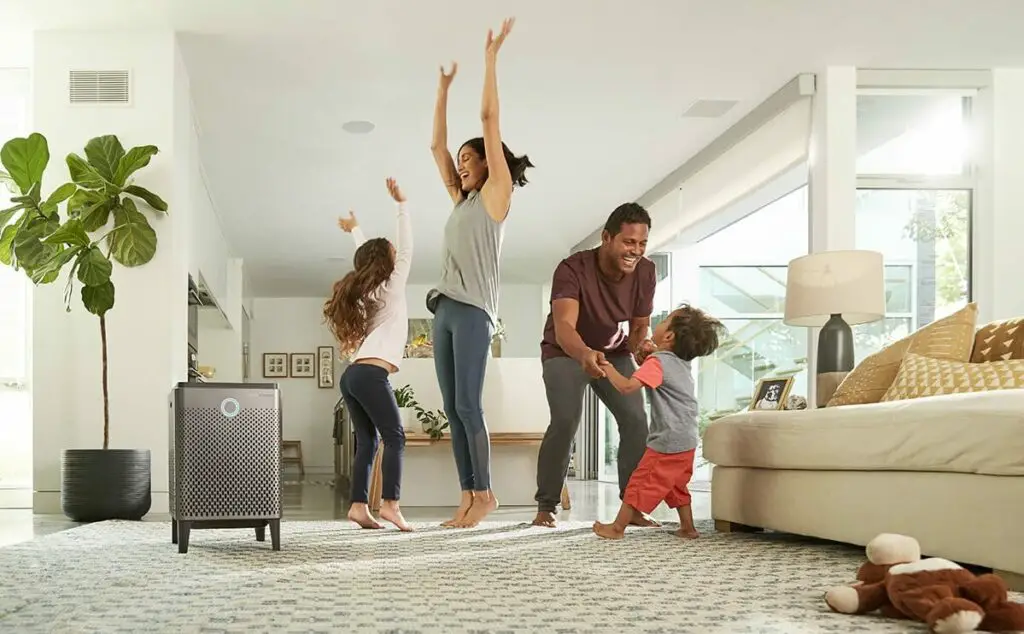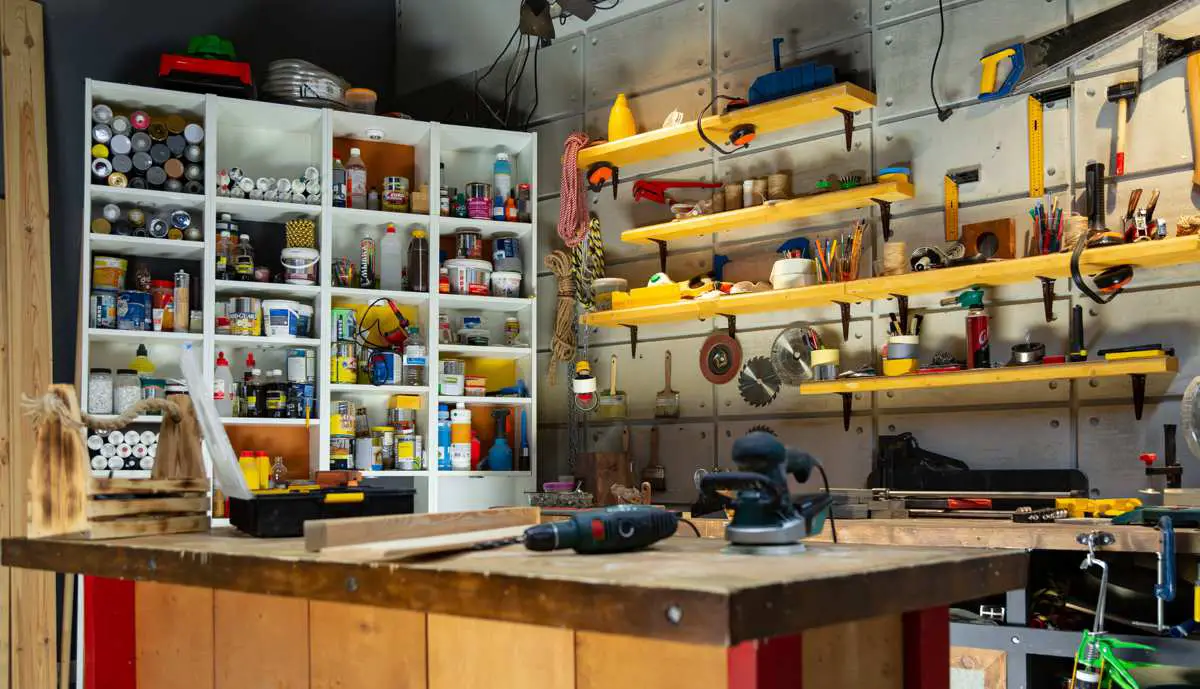A garage is great for DIY as well as storing cars. It’s a very useful space in which power tools can be used (airborne particles created), cars mended (exhaust fumes with particles and chemicals produced) and painting of objects, including spray painting of cars done(release of chemicals into the air). Even cleaning the garage will release significant amounts of dust into the air.
Alternatively you may use it as a gym and be breathing in large volumes of air from the garage as you exercise.
The health problems caused by air pollution are now indisputable. Some of the most common are heart attacks, strokes and dementia. In 98% of the US for which there is data, the fine particulate matter in outdoor air is above the WHO safe level. So unfortunately particulate pollution affects us all. Please see this article, The Health Effects of Airborne Particles and Chemicals.
Your home’s HVAC system cannot help as a garage is not allowed to be connected to your home’s HVAC system according to building regulations. The fact that an HVAC system cannot be connected to a garage already shows you that significant air pollution is envisaged in a garage which should not escape into the indoor air. So it is natural to consider an air purifier for the garage as a solution.
The best garage air purifier to remove particles from the air is the SmartAir Blast Industrial and for removing chemicals from the air the iQair MultiGas. However, high flow ventilation and an elastomeric mask with high grade filters are key for dealing with the peaks of pollution.
Peaks of pollution are not easily dealt with using an air purifier. It will take an air purifier about 30 – 60 minutes to go from a high level of pollution down to a level as low as the air purifier can sustain.

Powerful, ventilation in a garage, much like an extractor fan over cooking stove, can reduce pollution levels much quicker than this.
One mode of ventilation is to have the garage doors open when creating particle or chemical pollution. However, it may be necessary to have the doors of the garage closed, because of the weather, crime rate etc. If so there is naturally a buildup particles or chemicals eg from paint, in the air.
In either case a powerful extraction fan with the outlet through the wall the furthest from the doors as possible, will be very effective.
Air purifiers produce really clean air but act relatively slowly. There is an excellent article on buying an air purifier, but in summary you need to look for-
- True HEPA filter-this will reduce the very small particles in exhaust fumes as well as dust particles, dirt particles, pet dander……..
- High enough airflow (CADR) for the size of your garage
- An activated carbon filter to remove chemicals and odor (odor is caused by volatile organic compounds VOCs)
- A “smart” air purifier, that is one that can be scheduled to come on at different times according to your schedule either via WIFI or a smart plug
In this article I outline why these are the best garage air purifiers and important other measures that you should take when doing DIY in a garage.

1)Best Air Purifier Choice if Particle Reduction in the Air is Most Important to You
SmartAir-Blast Air Purifier (very very powerful air flow at relatively low noise)

In this case you will need an air purifier with a very high air flow. This is because garage doors are not airtight so that air with fine particles will continuously be entering the garage, and also because a garage is usually larger than an average room.
For these reasons the Smart Air Blast would be an ideal choice. It has a very capable HEPA filter combined with a higher air flow than any other air purifier on the residential market.
Its air flow is tremendous, but to produce this air flow it is naturally a larger air purifier. Before buying it please check that you have the space for it.
| Filters | |
| HEPA filter | HEPA H13 |
| Carbon filter amount of carbon | 4 lbs |
| Filter Change HEPA (Particles) | 14 months |
| Filter Change Carbon (Chemicals) | Smell test* |
| Airflow | |
| CADR at =<50db (CADR on Maximum) | 401 cfm |
| Maximum Room Size (Noise less than 50db*) | 619 sq ft |
| Maximum Room Size (On noisiest setting) | 810 sq ft** |
| ** only slightly over 50db at 51 db | |
| Smart Control | Yes via smart plug |
| Power | 118 W |
| Weight | 84 lbs |
| Dimensions “H x “W x D” | 48.4 x 22.6 x 13 |
| Annual Running Cost Electricity ($) | $70*** |
| Annual Running Cost Filters ($) | $236*** |
| Total Annual Running Cost ($) | $300*** approximately |
* SmartAir recommend removing the filter and smelling it. If it smells sour, acidic or chemical then it is saturated and should be replaced
*** these figures are for running the air purifier 12 hours per day 365 days per year. So for a garage the number of hours the air purifier is used is likely to be much much fewer than this usage and the cost relatively small.
All the above are approximate and assume running the air purifier for 12 hours per day on the highest setting that keeps the noise below the level specified in db in the table. This is less than or equal to 50db in normal daytime use and 35db for bedrooms.
*Most people will not wish to have the air purifier on a setting louder than about 35db for sleeping in a bedroom-you may wish to have a quieter setting than 35db this is just a ballpark estimate for most people. On the other hand, if your room layout allows you to be much further than 6 feet from the air purifier you may find the noise this machine makes at top speed is alright. The calculations for room size assume that you have 8 foot ceilings and 5 air changes per hour.
Never run an air purifier on auto mode using the inbuilt sensor. These cannot detect ultrafine particles which are damaging to human health, please see this article- How to test the air quality in your home.
2) Best Air Purifier Choice if Chemical Reduction in the Air is Most Important for You
iQair Multigas (supreme chemical filter specification and supreme particle filter)
The air coming out of this air purifier will be better than any other air purifier on the market. It is specified to remove 99.5% of particles greater than 0.003um, the best particle specification on the market. Its removal of chemical compounds may well be the best on the market as well, there is only one other air purifier that comes close.
No pre-filter cleaning needed, this is quite an advantage as almost all other air purifiers have a type of pre-filter which should theoretically be cleaned every 2-4 weeks.

| Filters | |
| HEPA filter | HEPA specified to remove 99.8% of ultrafine particles down to a size of 0.003um |
| Carbon filter amount of carbon (lb) | 12 lb so so 100x more than some other air purifiers |
| Filter Change HEPA (Particles) | 12 months |
| Filter Change Carbon (Chemicals) | 29 months |
| Airflow | |
| CADR at =<50db (CADR on Maximum) | 170 cfm |
| Maximum Room Size (Noise less than 50db*) | 262 sq ft |
| Maximum Room Size (On noisiest setting) | 462 sq ft |
| Smart Control | Yes smart plug |
| Power | 74 W |
| Weight | 44 lbs |
| Dimensions “H x “W x D” | 28x 15 x 16 |
| Annual Running Cost Electricity ($) | $45 |
| Annual Running Cost Filters ($) | $285 |
| Total Annual Running Cost ($) | $330 |
So if inhalation of chemicals are the main problem then this is the best garage air purifier for you. However you may need 2 of these if your garage is large to give adequate particle reduction.
3)Cheaper Alternatives
Coway 400S
A real contender for best garage air purifier because of its superb filter and high airflow a the lowest possible noise levels for the airflow.
Specifications

| Filters | |
| HEPA filter | HEPA specified to remove 99.8% of ultrafine particles down to a size of 0.01um |
| Carbon filter amount of carbon (lb) | 1.5 lb so more than most other air purifiers |
| Filter Change HEPA (Particles) | 12 months |
| Filter Change Carbon (Chemicals) | 12 months |
| Airflow | |
| CADR at =<50db (CADR on Maximum) | |
| Maximum Room Size (Noise less than 50db*) | 450 sq ft |
| Maximum Room Size (On noisiest setting) | 640 sq ft |
| Smart Control | Yes phone app |
| Power | 66 W |
| Weight | 24.7 lbs |
| Dimensions “H x “W x D” | 22.8 x 14.8 x 14.8 |
| Annual Running Cost Electricity ($) | $40 |
| Annual Running Cost Filters ($) | $120 |
| Total Annual Running Cost ($) | $160 |
4)Other measures
a)Wear An Elastomeric Mask With High Quality Filters
When you are actually working on something, you should consider wearing an elastomeric face mask with high-quality filters. If you are cutting, drilling, sanding, or planing wood or cutting or drilling metal using a mask is important. It will mean that only approximately one in 10,000 airborne particles will get through the filters of the mask into your lungs.
An air purifier will not protect you as-
- The particles may get directly to you before they have a chance to reach the air purifier
- The air purifier will not deal with peaks, it removes particles more slowly than you can generate them.
If you are painting using other volatile organic compounds the mask should have activated carbon filters to remove as much of the chemicals as possible.
So wearing a mask is very important, during peak release of either particles or chemicals neither ventilation nor an air purifier will be able to keep the levels in the air safe. Both will eventually be able to lower the concentrations to safe levels but this may take 30-60 minutes. So in the meantime you need the added protection of a well fitting mask with excellent filters. There is an article about masks to combat air pollution if you are interested.
b) Use a Vacuum Cleaner-for particles
If you are creating particles by cutting or drilling then it is helpful to have a vacuum continually sucking in the air with particles at the point on the material that you are cutting. In this way as many particles as possible are simply sucked into the vacuum cleaner and do not reach either you or the general area of the garage.
Some power tools come with attachements to make vacuum cleaner attachment easy to implement.
The vacuum should of course have a HEPA air filter to trap as many ultrafine airborne particles as possible.
c) Ventilation-especially for chemicals
An air purifier has a finite capacity for removing both particles and chemicals from the air. The particle filters become clogged up and the activated carbon filters become saturated with chemicals. So they will both need replacing the interval between replacements depending on the level of contamination.
So if you are going to be producing a large amount of either particles or chemicals ventilation will be an essential part of reducing the amount of either in the atmosphere.
Ventilation will also allow environmental particles to enter the garage. So once you have stopped creating particles, if you are not also using volatile organic chemicals then after a short period it is best to turn the ventilation off and let the air purifier further improve the airborne particle count.
Air Exchanger
An air exchanger will try to keep the garage at your chosen temperature while still allowing ventilation. Occasionally they will have filters in them even if they do these filters not the sort filters that will make a big difference to air quality.
So suppose it is cold outside and your garage is heated if you simply ventilate by ejecting air out of the garage cold air will come in and the temperature will drop. An air exchanger takes the heat from the air exiting and transfers as much as possible to the air coming in so reducing the amount of heat lost. Similarly if the garage is air conditioned in summer, the air exchanger will transfer heat from the air coming in to the air going out so cooling the air coming in. This will mitigate the temperature rise in the garage due to the loss of cold air.
So a heat exchanger can be a useful addition to a ventilation system but its effect will be limited at very high air flows.
Ventilation
a)Volatile Organic Compounds
Although fresh air coming into the garage makes an air purifier less effective at purifying the air there are times when this may be the best solution to the problem.
For instance if you have just been spray painting or varnishing something and there is lot of volatile organic compound in the garage air then ventilation is likely to be more effective than the air purifier.
It makes the air purifier less effective because ventilation is constantly removing the semi purified air from the garage and unpurified air is entering the garage. However this “unpurified air” will almost always have a much lower concentration of VOC than the semi purified air that the air purifier is in the process of purifying in the garage.
The new air coming in will have an extremely low level of VOC whereas the air going out will be full of VOC. In addition, the amount of air that you can remove with a ventilation fan in a given time will usually be much higher than the amount of air that an air purifier can process.
Also, the activated carbon filters in an air purifier can become saturated with VOCs and then stop absorbing VOCs.
So for VOCs ventilation is key when actually using materials releasing VOCs into the air. Air purifiers will have some effect whilst using them but will be more useful for background removal of VOCs after use of the material releasing VOCs.
Sources
- Ventilation
- Garage door not being air tight.

b)Airborne Particles
With airborne particles the situation is a little different. The air that will be ejected from the garage by ventilation will be full of particles but the air coming in will in most areas contain a significant number of fine particles. Fortunately the filters in an air purifier are better at removing particles than VOCs.
Also you can use other methods to reduce airborne particle count. When creating particles, for instance by cutting wood, as mentioned above ideally you would have a HEPA vacuum cleaner sucking in the air near the cutting edge to remove as many particles as possible.
However for airborne particles an air purifier can be very effective. Until of course the filters become clogged with particles.
Also if you are going to create an absolute cloud of particles it would be ideal to ventilate the garage whilst you are actually cutting and for 10 minutes or so afterwards. Then close the garage doors and rely on an air purifier to clean the air thoroughly.
For protecting yourself against particles whenever you do anything that is likely to produce airborne particles it is essential to wear an elastomeric mask with high quality filters. Air purifiers and even ventilation will not be able to keep up with the rate at which your power tools when they are in action can produce airborne particles.
Personally I think it is a good idea to put a mask with high quality filters on as you start preparing to do anything that will get particles or chemicals into the air. I find that once you get started on a job it is easy to forget to put a mask on. Also never think “this is just a quick job” I will just hold my breath and for it to take longer than envisaged. I have made both mistakes.
Conclusion-best garage air purifier
The ideal set up would be all 4 of these-
An air purifier specialising in high volume particle filtration such as the SmartAir Blast Industrial.
An air purifier specializing in the removal of chemicals from the air eg the iQair MultiGas. Or if possible use volatile organic compounds just outside the garage in the fresh air.
Wear an elastomeric mask with high quality filters.
Ventilation system ideally with an extractor fan, but failing that simply opening the main garage door. If you keep the garage doors shut a heat exchanger is a nice option to keep the garage temperature comfortable.
Cheapest Option for a Garage
The above is ideal but fairly expensive, here is the very cheapest option-
Particle filtration-Levoit 200S, 1 to 3 of these air purifiers, depending on the size of your garage. Run on full setting.
Volatile organic compounds-use these just outside the garage in the fresh air as any air purifier especially cheaper air purifiers will struggle with these.
Elastomeric mask-not very expensive everyone needs to use these for DIY.
Ventilation-box fan placed blowing air out of a door at the back of the garage or if no door at the back then on one side of the front door of the garage.
Total-in the region of $280 rather than $3000 for the ideal set up.

